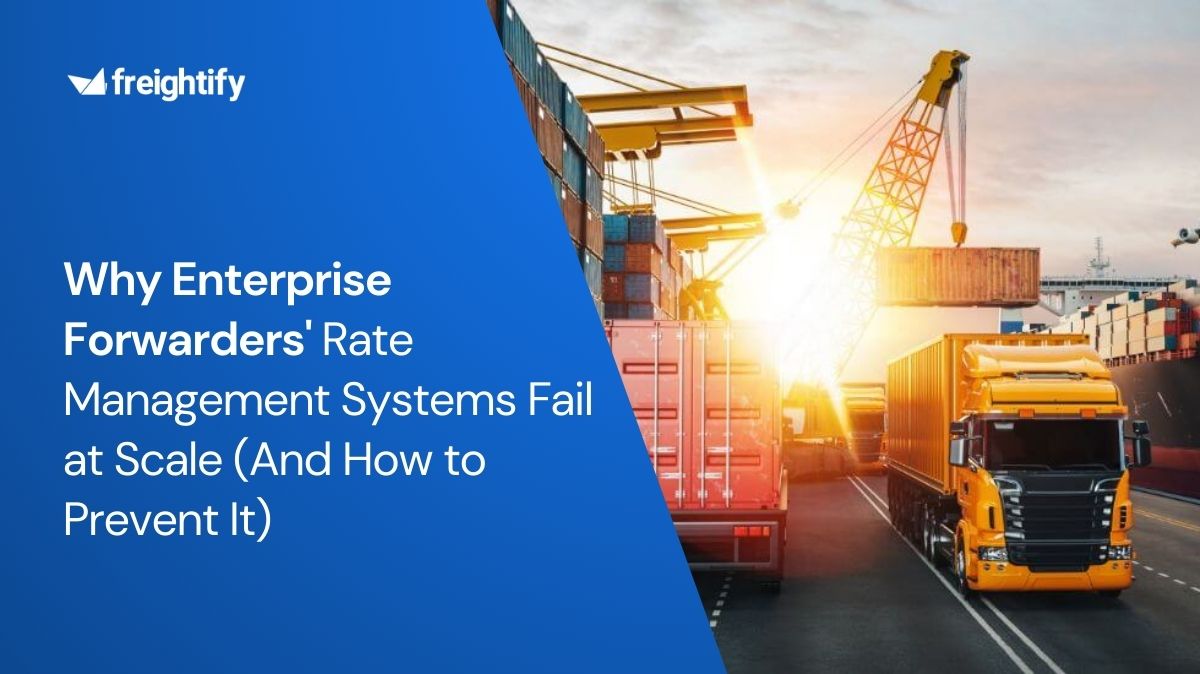Introduction: The Rise of Software for Transportation Management (TMS) The global Transportation Management Software (TMS) market is expected to reach $30 billion by 2027, driven by the increasing demand for real-time freight tracking, AI-based automation, and cost optimization. Over 75% of freight forwarders report that manual logistics processes slow down operations, leading to higher costs and inefficiencies. Investing in the best transportation management software helps businesses streamline shipments, optimize routes, and reduce costs.
What is Transportation Management Software (TMS)? A TMS is a digital platform designed to help businesses plan, execute, and optimize freight movement. It automates key logistics tasks such as route planning, shipment tracking, carrier selection, and freight cost analysis, making logistics operations faster and more efficient.
Let us help you with your journey
Procure, Manage and Quote freight prices (with ancillary charges) in under 2 minutes!
Why Do Freight Forwarders Need a TMS? Cost Reduction – Automates processes and optimizes transportation planning to cut logistics expenses.
Real-Time Shipment Tracking – Enhances efficiency with instant updates on freight movement.
Better Carrier Management – Improves collaboration between freight forwarders and logistics providers.
Minimized Errors – Reduces paperwork and human mistakes with AI-driven automation.
Scalability – Adapts to business growth with cloud-based transport management solutions.
Top 11 Best Transportation Management Software (TMS) Platforms in 2025Overview Choosing the right Transportation Management Software (TMS) is crucial for freight forwarders and logistics providers to optimize operations, reduce costs, and enhance shipment visibility. The best TMS software providers offer features like real-time freight tracking, AI-powered automation, route planning, carrier selection, and cost analysis. Whether you need a cloud-based transport management solution, AI-driven shipment management software, or an enterprise-grade TMS, this list covers the top 11 solutions to help businesses streamline logistics and drive profitability.
1. CargoWise – Best for Large Freight Forwarders Overview: CargoWise is a cloud-based transportation optimization software tailored for global logistics companies handling complex supply chain operations.
Key Features: Multimodal transport management (Air, Ocean, Road, Rail) Integrated compliance and customs automation AI-based shipment routing & cost optimization Advanced carrier contract management Pros: Scalable for large freight forwarders Strong global network for supply chain management Comprehensive reporting & analytics Cons: Expensive for small businesses Steep learning curve Service Locations: Available globally, with a strong presence in the USA, Europe, and Asia
Pricing: Quote-based pricing
Additionally, Freightify can easily integrate with your existing CargoWise TMS to increase efficiency as well as seamless operations and data exchange.
2. Magaya – Best for Small & Mid-Sized Freight Forwarders Overview: Magaya offers an all-in-one logistics and supply chain platform designed for freight forwarders, NVOCCs, and customs brokers.
Key Features: Automated shipment processing & real-time tracking Customs compliance management AI-based rate comparison & carrier selection Built-in accounting and finance tools Pros: User-friendly interface Affordable for small businesses Multi-modal freight support Cons: Limited integrations compared to enterprise solutions Service Locations: USA, Canada, Latin America, Europe
Pricing: Mid-range pricing with flexible plans
Moreover, Freightify can easily integrate and help in migrating data seamlessly, to and fro with your existing Magaya TMS.
3. Blue Yonder – Best for AI-Powered Freight Optimization Overview Blue Yonder offers predictive analytics and AI-powered automation for logistics companies managing high shipment volumes.
Key Features AI-powered demand forecasting Automated route planning & load balancing Multi-modal transportation optimization Dynamic freight cost analytics Pros Strong AI capabilities Scalable for large enterprises Best transportation management system for data-driven decisions Cons Requires technical expertise for setup Service Locations Global coverage, including North America & Europe
Pricing Enterprise-level pricing
4. Kuebix – Best for Small & Mid-Sized Freight Businesses Overview Kuebix provides scalable TMS solutions, offering a free version for small businesses and enterprise-level tools for larger supply chains.
Key Features Cloud-based TMS with freight management Real-time shipment visibility Automated shipment booking and invoice auditing Pros Affordable with a free version for startups Scalable for businesses of all sizes Easy-to-use interface Cons Lacks advanced features for global enterprises Limited integration options Service Locations Available in North America and Europe
Pricing Free basic version, enterprise pricing available
5. Oracle Transportation Management – Best for Large Enterprises Overview Oracle TMS is full-suite transportation solution designed for global freight companies needing a highly configurable, AI-driven logistics solution.
Key Features End-to-end freight lifecycle management AI-powered demand forecasting Automated carrier compliance & customs handling Pros Highly customizable Global freight network compatibility Robust automation for large-scale logistics Cons Complex setup & high learning curve Expensive for small businesses Service Locations Global coverage, including USA, Europe, and Asia
Pricing Enterprise-level pricing
6. SAP Transportation Management – Best for ERP Integration Overview SAP TMS is ideal for companies using SAP ERP, offering seamless integration with supply chain processes.
Key Features Freight order management & execution Real-time shipment tracking & cost managementMulti-modal transport support Pros Great for companies already using SAP Detailed analytics & real-time reporting Advanced transport planning tools Cons Expensive for small businesses Requires SAP expertise Service Locations Available worldwide
Pricing Custom pricing based on modules
7. TMC by C.H. Robinson – Best for Managed Transportation Services Overview TMC, a division of C.H. Robinson, is a global transportation management system designed for enterprises seeking end-to-end logistics visibility and managed transportation services. It provides advanced control tower solutions and AI-driven insights to optimize supply chain performance.
Key Features Global transportation visibility & control tower solutions AI-powered predictive analytics & automation Integration with various ERP & supply chain platforms Pros Strong global carrier network & 24/7 support Advanced analytics for real-time decision-making Scalable solutions for large enterprises Cons Higher cost compared to standard TMS solutions Best suited for large companies with complex logistics needs Service Locations Available worldwide
Pricing Custom pricing based on service level & business needs
8. Uber Freight – Best for On-Demand Freight Matching Overview Uber Freight is a digital freight brokerage platform that connects shippers with carriers through an intuitive, app-based system. It simplifies freight booking with real-time pricing and automated load matching, making it ideal for businesses seeking flexible and transparent shipping solutions.
Key Features Instant rate quotes & dynamic pricing Automated load booking & carrier matching Real-time tracking & analytics Pros Easy-to-use platform with quick onboarding Transparent pricing with no hidden fees Strong carrier network for reliable capacity Cons Limited advanced TMS features for complex logistics needs Primarily focused on North American markets Service Locations North America & expanding in Europe
Pricing No subscription fee; pricing varies based on freight rates & load requirements
9. PCS Signature TMS – Best for End-to-End Supply Chain Visibility Overview PCS Signature TMS is a cloud-based transportation management system designed for carriers, brokers, and shippers. It offers a unified platform with AI-driven automation, real-time visibility, and robust integrations to streamline freight operations.
Key Features End-to-end freight management for shippers, brokers & carriers AI-driven automation & predictive analytics Integrated accounting, dispatch, and compliance tools Pros Scalable solution for businesses of all sizes Strong integration with ELDs, ERP, and accounting software Real-time tracking & dynamic load optimization Cons Advanced features may require a learning curve Pricing structure may not be ideal for small businesses Service Locations Available in North America
Pricing Custom pricing based on business needs & feature selection
10. BluJay (now e2open TMS) – Best for Global Supply Chain Optimization Overview BluJay, now part of e2open, is a comprehensive transportation management system designed for global shippers seeking end-to-end logistics visibility, compliance, and optimization. It enables seamless multi-modal transportation planning with AI-driven automation and analytics.
Key Features AI-powered route optimization & freight management Multi-modal transportation support (road, rail, air, ocean) Integrated customs & trade compliance tools Pros Strong global network with real-time shipment visibility Scalable solution for enterprises & complex supply chains Advanced automation for cost-saving & efficiency Cons Requires integration expertise for full functionality Can be costly for smaller businesses Service Locations Available worldwide
Pricing Custom pricing based on enterprise needs & modules selected
Key Features to Consider in a Transport Management System Route Optimization Freight Tracking and Visibility Carrier Management Load Planning and Consolidation Compliance and Documentation Reporting and Analytics By prioritizing these key features when evaluating TMS options, businesses can choose a solution that meets their specific transportation management needs and enables them to achieve their operational and strategic objectives effectively.
What are the Benefits of using a Transport Management System?
Cost Reduction: By optimizing routes, consolidating shipments, and selecting the most cost-effective carriers, a TMS helps slash transportation expenses, boosting your bottom line.Simplified Processes: Say goodbye to cumbersome manual tasks. A TMS automates key functions like load planning, carrier selection, and documentation, streamlining your entire supply chain.Enhanced Visibility: With real-time tracking and monitoring capabilities, you gain unparalleled visibility into your shipments' status, enabling proactive decision-making and minimizing disruptions.Improved Efficiency: From faster billing cycles to smoother freight execution, a TMS boosts operational efficiency across the board, saving time and resources.Compliance Assurance: Navigate the labyrinth of trade regulations and compliance requirements effortlessly. A TMS keeps you abreast of changing regulations and ensures your shipments are always compliant.Time Savings: With streamlined processes and automated workflows, your team can focus on strategic initiatives rather than getting bogged down by manual tasks, resulting in faster delivery times and happier customers.Scalability: As your business grows, so does the complexity of your logistics operations. A TMS scales with your business, adapting to evolving needs and ensuring seamless expansion.Final Thoughts: The Best TMS Platforms for 2025 Choosing the best transport management software ensures cost savings, improved efficiency, and enhanced shipment tracking. Whether you need a scalable cloud-based TMS like Freightify, an enterprise-level system like Oracle, or a logistics-specific platform like CargoWise, the right transportation optimization software can transform your freight operations.
Looking for the best transportation management software?Get a Free Demo of Freightify Today!
Frequently Asked Questions (FAQs) about Transportation Management Software (TMS) What is a Transportation Management System (TMS) and how does it work? A Transportation Management System (TMS) is a logistics software that helps businesses plan, execute, and optimize the movement of freight. It works by automating key logistics tasks, such as:
Freight rate management – Comparing carrier pricing to get the best rates Shipment tracking – Providing real-time updates on deliveries Route optimization – Identifying the most cost-efficient shipping routes Carrier selection – Matching the right carrier with each shipment A TMS integrates with freight carriers, warehouses, and ERP systems to improve logistics efficiency and reduce transportation costs.
What are the benefits of using a TMS for freight forwarders? Freight forwarders benefit greatly from a TMS software provider because it helps:
Reduce transportation costs by optimizing routes and carrier selection Improve shipment tracking with real-time visibility Eliminate manual errors by automating documentation and invoicing Enhance operational efficiency by integrating with existing supply chain systems Scale business growth with cloud-based TMS solutions With AI-powered transportation management software, freight forwarders can streamline complex logistics while ensuring faster and more cost-effective shipments.
How do I choose the best TMS software for my business? When selecting a TMS software provider, consider the following factors:
Scalability – Can the TMS grow with your business? Integration capabilities – Does it connect with your ERP, warehouse, and freight carriers? User-friendliness – Is the interface intuitive for your team? Automation & AI – Does it offer real-time tracking, automated rate comparison, and AI-driven route planning? Transport Management System Cost – Does it fit within your budget? Popular choices include Freightify (for freight rate management), CargoWise (for large enterprises), and Oracle TMS (for global logistics).
What is the difference between cloud-based and on-premise TMS software? The main difference between cloud-based and on-premise TMS is how they are hosted and managed:
Hosted online (no need for physical servers) Easy to update and scale Lower upfront costs, subscription-based pricing Accessible from anywhere Installed on company-owned servers Higher control over security and customization Higher upfront cost but no ongoing subscription fees Requires in-house IT maintenance Most modern freight forwarders prefer cloud-based TMS solutions due to their flexibility, real-time updates, and lower costs.




















